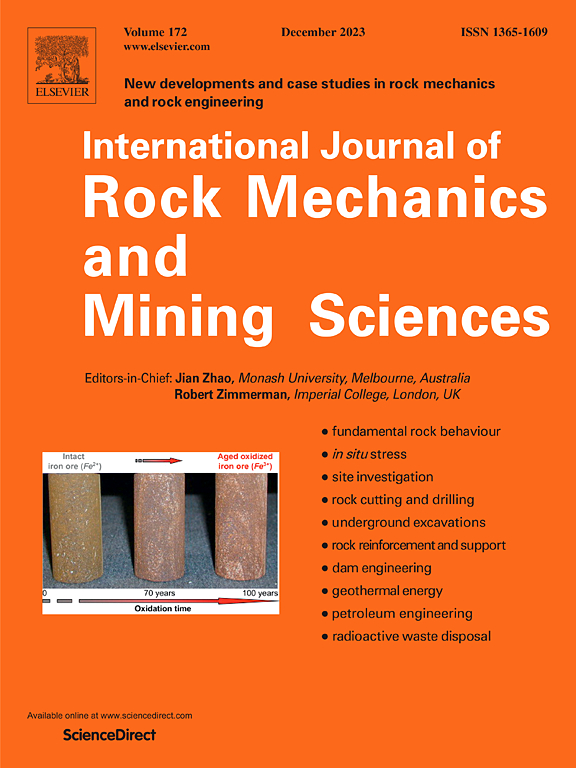基于速率过程理论的离散元法模拟软岩巷道实际收敛
IF 7.5
1区 工程技术
Q1 ENGINEERING, GEOLOGICAL
International Journal of Rock Mechanics and Mining Sciences
Pub Date : 2025-06-06
DOI:10.1016/j.ijrmms.2025.106172
引用次数: 0
摘要
隧道开挖引起的软岩蠕变对安全施工造成重大挑战。本文建立了结合速率过程理论(RPT)和支护特征曲线(SCC)方法的离散元法(DEM)数值模型,对软岩巷道蠕变收敛进行了数值模拟。为了实现这一目标,使用粒子构建二维(2D) DEM隧道模型,并通过线性和平关节接触模型的混合组合模拟它们的相互作用。RPT通过用户定义的Visual c++脚本集成到这些模型中,该脚本在DEM模拟过程中根据颗粒之间的相对速度调整摩擦系数。采用单轴压缩多阶段蠕变试验标定了完全风化花岗岩的细观力学参数,并将其应用于隧道开挖模拟。使用SCC方法计算得到的支撑力,通过使用定义的FISH函数应用于隧道颗粒。隧道线性颗粒的位移随时间变化,分析中考虑了模拟支护系统的时变特性。利用某隧道现场监测数据验证了所建立模型的数值结果。结果表明,计算的收敛值与监测数据在数值和变形趋势上都很吻合。本文章由计算机程序翻译,如有差异,请以英文原文为准。
Simulation of real tunnel convergences in soft rock using Discrete Element Method with Rate Process Theory
Creep deformation of soft rock caused by tunnel excavation can produce significant safety and construction challenges. In this study, a Discrete Element Method (DEM) numerical model combining the Rate Process Theory (RPT) is developed, in conjunction with the Support Characteristic Curve (SCC) approach, to simulate creep-induced convergences of a tunnel excavated in soft rock. To achieve this, two-dimensional (2D) DEM tunnel models are constructed using particles, and their interactions are simulated by a hybrid combination of the linear and flat-joint contact models. The RPT is integrated into such models through a user-defined Visual C++ script, which adjusts their friction coefficients during the DEM simulation based on the relative velocity between particles. The micromechanical parameters of completely weathered granite were calibrated by uniaxial compression multi-stage creep tests (UCMCTs) and applied to the tunnel excavation simulation. The support forces, as computed using the SCC approach, are applied to the tunnel particles using a used-defined FISH function. The displacements of the tunnel linear particles change over time, the time-dependent behavior of the simulated support system is accounted for in the analysis. Numerical results obtained with the developed model were validated using field monitoring data collected from a tunnel case study. Results indicate that computed convergences align well with the monitoring data, both in terms of values and of deformation trends.
求助全文
通过发布文献求助,成功后即可免费获取论文全文。
去求助
来源期刊
CiteScore
14.00
自引率
5.60%
发文量
196
审稿时长
18 weeks
期刊介绍:
The International Journal of Rock Mechanics and Mining Sciences focuses on original research, new developments, site measurements, and case studies within the fields of rock mechanics and rock engineering. Serving as an international platform, it showcases high-quality papers addressing rock mechanics and the application of its principles and techniques in mining and civil engineering projects situated on or within rock masses. These projects encompass a wide range, including slopes, open-pit mines, quarries, shafts, tunnels, caverns, underground mines, metro systems, dams, hydro-electric stations, geothermal energy, petroleum engineering, and radioactive waste disposal. The journal welcomes submissions on various topics, with particular interest in theoretical advancements, analytical and numerical methods, rock testing, site investigation, and case studies.

 求助内容:
求助内容: 应助结果提醒方式:
应助结果提醒方式:


